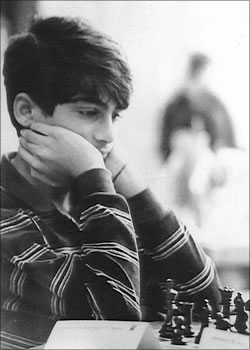The Rise of the “Asian Dragons”
What successful examples can Black players around the world examine as successful models in building legacies? We have heard ad infinitum, the legend about the famous Soviet chess schools mechanically cranking out World Champions.

Photo by ChessBase
Of more recent history, Hungary has produced some extraordinary talent in super-GM Peter Leko, the Almasi brothers, and the Polgar sisters. But as of late, the Asian region has become a hotbed of chess activity spurred in part by the success of India’s GM Viswanathan Anand and China’s GM Xie Jun, the current Women’s World Champion.
Because of these important role models, it is no accident that India has produced a pack of young male IMs and China has produced a deep contingent of dazzling female players. Certainly, GM Xie Jun may have influenced one of the world’s youngest GM in 15-year old GM Bu Xiangzhi (2558), while GM Anand may certainly have influenced 21-year old Indian phenom, WIM Subbaraman Vijayalakshmi (2416).
However, we cannot discount the importance of role models (with respect to gender) in developing confidence in national chess excellence. Below are the five up-and-coming players after the aforementioned champions. The Chinese women are about 12-deep which includes, Liu Pei (2378), an untitled 12-year old!
      |
|---|
GM Xie Jun (2557), 30 yrs.
WGM Zhu Chen (2538), 24 yrs.
WGM Wang Pin (2506), 25 yrs.
WGM Xu Yuhua (2500), 24 yrs.
WGM Qin Kanying (2489), 26 yrs.
WGM Wang Lei (2473), 25 yrs.
The Asian Formula
Both China and India have been notable examples of how players with a thriving chess culture can achieve incredible feats. Chinese chess is firmly backed by the government, and by no small means, the tradition of Chinese chess (“xiangqi”) and martial arts. In addition, the organized system of collaboration is intrinsic in Chinese culture and helps to create harmony between the players so that there is not excessive competition and jealously.
India, the region from whence one of the oldest versions of chess sprouted, is rapidly becoming a world chess power. The high-tech boom has also created opportunities for sponsorships. Indian chess has been supported by the high tech community as many high profile tournaments have been sponsored in the vast country. In addition, Indian players like GM Krishnan Sasikiran have picked up sponsors in the high-tech industry to aid them in their personal development.
            |
|---|
GM Viswanathan Anand (2794), 31 yrs.
GM Krishnan Sasikiran (2611), 20 yrs.
GM Abhijit Kunte (2568), 23 yrs.
IM P. Harikrishna (2504), 14 yrs.
IM Surya Sikhar Ganguly (2456), 17 yrs.
IM Chanda Sandipan (2424), 17 yrs.
Since the breakup of the Soviet Union, talent has been spread thin as many national teams tout Soviet GMs. However, it may be that nurturing environments (including government support), and the spiritual foundation that will vault Asia into the highest heights of chess. No longer will we assume (as GM Kasparov once did) that the “chess world,” only exists in the West. The sun in the east is rising and we should take note!


Who Will Rise Next?
If nothing else, chess players of the African Diaspora should be able to draw inspiration from the rise of chess in Asia. A system of collaboration through networking is key to producing more opportunities to earn chess excellence. For many years, questions have been raised about the scarcity of titled Black players around the world. If Black chess players are to succeed, there has to begin a system of collaboration and cooperation. Online tournaments and discussion, collaborative study groups, and invitationals are ways to bridge the gap. This has begun to happen.
Remember. . . one cannot be selfish. In order for one to receive assistance, he/she must also provide assistance. In addition, because someone is rated a bit lower, does not mean they cannot help you. How many of us have analysis partners, or played for coaches to whom we were superior in skill and talent, but they helped us to channel that energy? Perhaps one day, a Black GM playing on one of the top boards in a major tournament will no longer be a rare occurrence. Let’s begin to collaborate so we can also make our mark in the annals of chess history!
